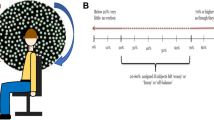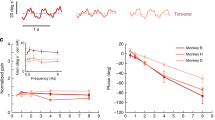Abstract
Gain modulation is believed to be a common integration mechanism employed by neurons to combine information from various sources. Although gain fields have been shown to exist in some cortical and subcortical areas of the brain, their existence has not been explored in the brainstem. In the present modeling study, we develop a physiologically relevant simplified model for the angular vestibulo-ocular reflex (VOR) to show that gain modulation could also be the underlying mechanism that modifies VOR function with sensorimotor context (i.e. concurrent eye positions and stimulus intensity). The resulting nonlinear model is further extended to generate both slow and quick phases of the VOR. Through simulation of the hybrid nonlinear model we show that disconjugate eye movements during the VOR are an inevitable consequence of the existence of such gain fields in the bilateral VOR pathway. Finally, we will explore the properties of the predicted disconjugate component. We will demonstrate that the apparent phase characteristics of the disconjugate response vary with the concurrent conjugate component.








Similar content being viewed by others
References
Andersen, R., & Mountcastle, V. (1983). The influence of the angle of gaze upon the excitability of light-sensitive neurons of the posterior parietal cortex. Journal of Neuroscience, 3, 532–548.
Bizzi, E., Giszter, S., Loeb, E., Mussa-Ivaldi, F., & Saltiel, P. (1995). Modular organization of motor behavior in frog’s spinal cord. Journal of Neuroscience, 18, 442–446.
Brotchie, P., Andersen, R., Snyder, L., & Goodman, S. (1995). Head position signals used by parietal neurons to encode location of visual stimuli. Nature, 375, 232–235.
Buizza, A., Avanzini, P., Schmid, R. (1981). Mathematical and computational methods in physiology. Oxford: Pergamon.
Busettini, C., Miles, F., Schwarz, U., & Carl, J. (1994). Human ocular responses to translation of the observer and of the scene: dependence on viewing distance. Experimental Brain Research, 100, 484–94.
Cartwright, A., Gilchrist, D., Burgess, A., & Curthoys, I. (2003). A realistic neural network simulation of both slow and quick pahse components of the guinea pig vor. Experimental Brain Research, 149, 299–311.
Chan, W., & Galiana, H. (2005). Integrator function in the oculomotor system is dependent on sensory context. Journal of Neurophysiology, 93, 3709–3717.
Chen-Huang, C., & McCrea, R. (1997). Viewing distance related changes in the linear responses of vor neurons during combined angular and linear head movements. Soc Neurosci Abstr, 23, 7.
Chen-Huang, C., & McCrea, R. (1998). Contribution of vestibular nerve irregular afferents to viewing distance-related changes in the vestibulo-ocular reflex. Experimental Brain Research, 119, 116–130.
Chen-Huang, C., & McCrea, R. (1999). Effects of viewing distance on the responses of horizontal canal-related secondary vestibular neurons during angular head rotation. Journal of Neurophysiology, 81, 2517–2537.
Cheron, G., & Godaux, E. (1987). Disabling of the oculomotor nuclei integrator by kainic acid injections in the prepositus-vestibular complex of the cat. Journal of Physiology (London), 394, 267–290.
Collewijn, H., & Noorduin, H. (1972). Conjugate and disconjugate optokinetic eye movements in the rabbit, evoked by rotatory and translatory motion. Pflugers Archives, 335, 173–185.
Crane, B., & Demer, J. (1997). Human gaze stabilization during natural activities: Translation, rotation, magnification and target distance effects. Journal of Neurophysiology, 78, 2129–2144.
Crane, B., & Demer, J. (1998). Human horizontal vestibulo-ocular reflex initiation: Effects of acceleration, target distance, and unilateral deafferentation. Journal of Neurophysiology, 80, 1151–1166.
Crane, B., Viirre, E., & Demer, J. (1997). The human horizontal vestibulo-ocular reflex during combined linear and angular acceleration. Experimental Brain Research, 114, 304–320.
Crawford, J., & Vilis, T. (1993). Modularity and parallel processing in the oculomotor integrator. Experimental Brain Research, 96, 443–456.
Cullen, K., & McCrea, R. (1993). Firing behavior of brainstem neurons during voluntary cancellation of the horizontal vestibuloocular reflex I. secondary vestibular neurons. Journal of Neurophysiology, 70, 828–843.
Cullen, K., Chen-Huang, C., & McCrea, R. (1993). Firing behavior of brain stem neurons during voluntary cancellation of the horizontal vestibuloocular reflex. II. eye movement related neurons. Journal of Neurophysiology, 70, 844–856.
Galiana, H. (1991). A nystagmus strategy to linearize the vestibulo-ocular reflex. IEEE Transactions on Biomedical Engineering, 38, 532–543.
Galiana, H., & Outerbridge, J. (1984). A bilateral model for central neural pathways in the vestibuloocular reflex. Journal of Neurophysiology, 51, 210–241.
Green, A., & Galiana, H. (1996). Exploring sites for short-term vor modulation using a bilateral model. Annals of the New York Academy of Sciences, 781, 625–628.
Hikosaka, O., Igusa, Y., & Imai, H. (1980). Inhibitory connections of nystagmus-related reticular burst neurons with neurons in the abducens, prepositus hypoglossi and vestibular nuclei in the cat. Experimental Brain Research, 39, 301–311.
Hine, T. (1990). Effects of asymmetric vergence on compensatory eye movements during active head rotation. J Vestib Res, 1, 357–371.
Hine, T., & Thorn, F. (1987). Compensatory eye movements during active head rotation for near targets: effects of imagination, rapid head oscillation and vergence. Vision Research, 27, 1639–1657.
Igusa, Y., Sasaki, S., & Shimazu, H. (1980). Excitatory premotor burst neurons in the cat pontine reticular formation related to the quick phase of vestibular nystagmus. Brain Research, 182, 451–456.
Ito, J., Markham, C., & Curthoys, I. (1986). Direct projection of type II vestibular neurons to eye movement-related pause neurons in the cat pontine reticular formation. Experimental Neurology, 91, 331–342.
Keller, E. (1974). Participation of medial pontine reticular formation in eye movement generation in monkey. Journal of Neurophysiology, 37, 316–332.
Khojasteh, E., & Galiana, H. (2006). A nonlinear model for context-dependent modulation of the binocular VOR. IEEE Transactions on Biomedical Engineering, 53, 986–995.
Khojasteh, E., & Galiana, H. (2007). Modulation of vergence during the vestibulo-ocular reflex. In Proc 29th annu int’l IEEE EMBS conf (pp. 5377–5380). Lyon, France.
Khojasteh, E., & Galiana, H. (2008). Neural computation in the binocular vor circuit: A theoretical study. In Proc 30th annu int’l IEEE EMBS conf (pp. 5518–5521). Vancouver, Canada.
Khojasteh-Lakelayeh, E., & Galiana, H. (2003). Context-dependence of the binocular vor; an emerging property of brainstem circuit topology. In Proc 25th annu int’l IEEE EMBS conf (Vol. 2, pp. 1738–1741). Cancun, Mexico.
Kitama, T., Ohki, Y., Shimazu, H., Tanaka, M., & Yoshida, K. (1995). Site of interaction between saccade signals and vestibular signals induced by head rotation in the alert cat: Functional properties and afferent organization of the burster-driving neurons. Journal of Neurophysiology, 74, 273–287.
Lasker, D., Ramat, S., Carey, J., & Minor, L. (2002). Vergence-mediated modulation of the human horizontal angular vor provides evidence of pathway-specific changes in vor dynamics. Annals of the New York Academy of Sciences, 956, 324–337.
Lisberger, S., Pavelco, T., & Broussard, D. (1994). Neural basis for motor learning in the vestibuloocular reflex of primates. I. changes in the responses of brain stem neurons. Journal of Neurophysiology, 72, 928–953.
Luebke, A., & Robinson, D. (1994). Gain changes of the cat’s vestibulo-ocular reflex after flocculus deactivation. Experimental Brain Research, 98, 379–390.
Maruta, J., MacDougall, H., Simpson, J., Raphan, T., & Cohen, B. (2006). Eye velocity asymmetry, ocular orientation, and convergence induced by angular rotation in the rabbit. Vision Research, 46, 961–969.
McConville, K., Tomlinson, R., & NA, E. (1996). Behavior of eye-movement-related cells in the vestibular nuclei during combined rotational and translational stimuli. Journal of Neurophysiology, 76, 3136–3148.
McCrea, R., Chen-Huang, C., Belton, T., & Gdowski, G. (1996). Behavior contingent processing of vestibular sensory signals in the vestibular nuclei. Annals of the New York Academy of Sciences, 781, 292–303.
Medendorp, W., Gisbergen, J. V., Pelt, S. V., & Gielen, C. (2000). Context compensation in the vestibuloocular reflex during active head rotations. Journal of Neurophysiology, 84, 2904–2917.
Minor, L., Lasker, D., Backous, D., & Hullar, T. (1999). Horizontal vestibuloocular reflex evoked by high- acceleration rotations in the squirrel monkey. I. normal responses. Journal of Neurophysiology, 82, 1254–1270.
Paige, G. (1983). Vestibuloocular reflex and its interaction with visual following mechanisms in squirrel monkey. I. response characteristics in normal animals. Journal of Neurophysiology, 49, 134–151.
Paige, G., Telford, L., Seidman, S., & Barnes, G. (1998). Human vestibuloocular reflex and its interactions with vision and fixation distance during linear and angular head movement. Journal of Neurophysiology, 80, 2391–2404.
Pastor, A., Cruz, R. D. L., & Baker, R. (1992). Characterization and adaptive modification of the goldfish vestibuloocular reflex by sinusoidal and velocity step vestibular stimulation. Journal of Neurophysiology, 68, 2003–2015.
Precht, W., & Anderson, J. (1979). Effects of cerebellectomy on the cat’s vertical vestibuloocular reflex. Pflügers Archiv, 382, 51–55.
Robinson, D. (1981). The use of control systems analysis in the neurophysiology of eye movements. Annual Review of Neuroscience, 4, 463–503.
Robinson, D. (1989). Integrating with neurons. Annual Review of Neuroscience, 12, 33–45.
Salinas, E., & Thier, P. (2000). Gain modulation: A major computational principle of the central nervous system. Neuron, 27, 15–21.
Scudder, C., & Fuchs, A. (1992). Physiological and behavioral identification of vestibular nucleus neurons mediating the horizontal vestibuloocular reflex in trained rhesus monkeys. Journal of Neurophysiology, 68, 244–264.
Shimazu, H., & Precht, W. (1966). Inhibition of central vestibular neurons from the contralateral labyrinth and its mediating pathway. Journal of Neurophysiology, 29, 467–492.
Snyder, L., & King, W. (1992). Effects of viewing distance and location of the axis of head rotation on the monkey’s vestibuloocular reflex. I. eye movement responses. Journal of Neurophysiology, 67, 861–874.
Strassman, A., Highstein, S., & McCrea, R. (1986a). Anatomy and physiology of saccadic burst neurons in the alert squirrel monkey. I. excitatory burst neurons. Journal of Comparative Neurology, 249, 337–357.
Strassman, A., Highstein, S., & McCrea, R. (1986b). Anatomy and physiology of saccadic burst neurons in the alert squirrel monkey. II. inhibitory burst neurons. Journal of Comparative Neurology, 249, 358–380.
Viirre, E., Tweed, D., Milner, K., & Villis, T. (1986). A reexamination of the gain of the vestibuloocular reflex. Journal of Neurophysiology, 56, 439–450.
Zee, D., Yamazaki, A., Buttler, P., & GuCer, G. (1981). Effects of ablation of flocculus and paraflocculus of eye movements in primate. Journal of Neurophysiology 46, 878–899.
Zhou, W., & King, W. (1996). Ocular selectivity of units in oculomotor pathways. Annals of the New York Academy of Sciences, 781, 724–728.
Zhou, W., Youguo, X., Simpson, I., & Yidao, C. (2007). Multiplicative computation in the vestibulo-ocular reflex (vor). Journal of Neurophysiology, 97, 2780–2789.
Acknowledgements
Supported by grants from the Canadian 797 Institute of Health Research (CIHR).
Author information
Authors and Affiliations
Corresponding author
Additional information
Action Editor: Carson C. Chow
Appendix
Appendix
The addition of cerebellar pathways to the current model can improve the gaze holding time constant in darkness. To demonstrate this, two of the many possible scenarios are presented in Fig. 9. Dashed pathways in Fig. 9(a), (b) show postulated pathways to-from the cerebellum. Both (a) and (b) include the inhibitory pathway from cerebellar gaze-velocity Purkinje cells (PJ) to the EHV (or FTN) neurons. PJ neurons receive ipsilateral vestibular input from primary afferents. They also receive an input from the paramedian tract neurons in the brainstem. In (a) we assume that they receive the efference copy of eye position commands, and in (b), a copy of the motor neuron drive. This is only a simplistic assumption for the sake of demonstrating how adding cerebellar loops will improve gaze holding in the model. An extensive study of the literature will be needed to exactly determine the cell types that project to the PJ cells.
The two gaze holding time constants from the new structure in Fig. 9(a) will be:
The two gaze holding time constants from the new structure in Fig. 9(b) will be:
The effect of adding the cerebellar loop is emphasized with bold letters in the above equations. By comparing the new time constants (Eq. (6a), (6b), (7a), (7b)) with Eqs. (2a) and (2b), it can be shown that the model time constants will become larger in both structures of Fig. 9. However, as mentioned in the Discussion, adding new pathways may require adjustments to some model parameters to preserve the desired global performance.
Rights and permissions
About this article
Cite this article
Khojasteh, E., Galiana, H.L. Implications of gain modulation in brainstem circuits: VOR control system. J Comput Neurosci 27, 437–451 (2009). https://doi.org/10.1007/s10827-009-0156-4
Received:
Revised:
Accepted:
Published:
Issue Date:
DOI: https://doi.org/10.1007/s10827-009-0156-4





